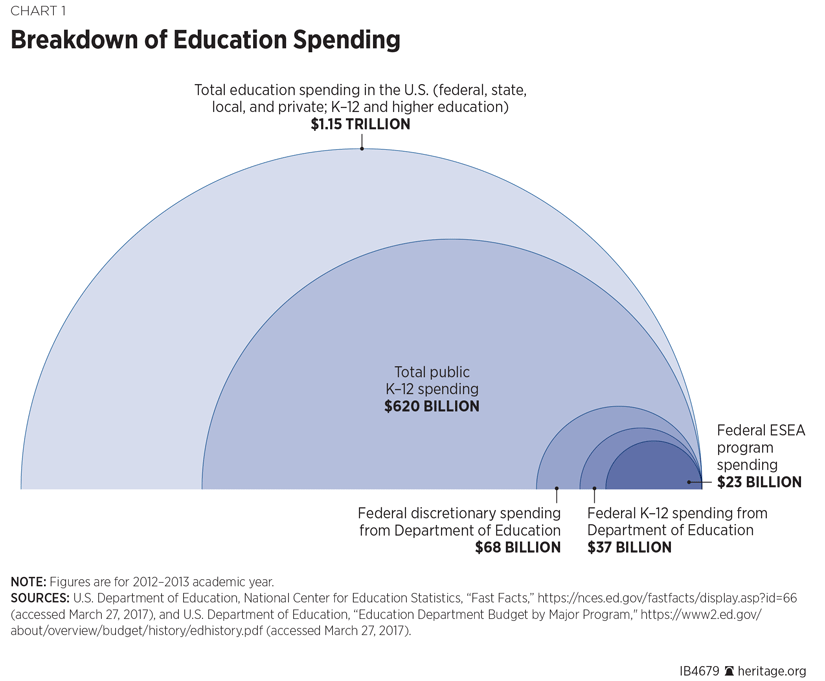The Administration of President Donald Trump has supported the worthwhile goal of advancing school choice for families across the country. The Academic Partnerships Lead Us to Success (A-PLUS) proposal, which would restore state and local control of education, is one vehicle for advancing this long-overdue reform.
A-PLUS would allow states to opt out of programs that fall under the Every Student Succeeds Act (ESSA)—formerly known as No Child Left Behind (NCLB), itself the seventh reauthorization of the Elementary and Secondary Education Act (ESEA)—and direct funding toward any education purpose or program authorized by state law. The proposal would give states the option to focus spending on education initiatives that work for their communities by freeing some $23 billion in federal funding authorized under ESSA that otherwise would be used to fund dozens of ineffective and duplicative federal programs.
A-PLUS could capitalize on a critical moment for school choice: With champions in the U.S. Department of Education, the White House, and Congress, and with overwhelming conservative leadership in the states, momentum for school choice has never been greater. This important reform would devolve dollars and decision-making power from Washington, enabling states to lead on education choice by freeing them from the programmatic labyrinth of ESSA. The Administration and Congress could then concentrate on advancing education choice in areas that fall within the federal purview.
Purpose of A-PLUS
The A-PLUS proposal has three guiding purposes:
- Give flexibility to states and local communities;
- Reduce administrative costs and the federal compliance burden associated with accessing federal education funding; and
- Free states and localities from their role as compliance entities subordinate to the federal government, making them accountable to parents and taxpayers instead.
Each of these purposes reflects long-overdue reforms in federal K–12 education policy.
Providing Flexibility to States and Local Communities. Greater flexibility for states and local communities reflects the reality that states and local school districts are better positioned than distant federal policymakers to understand and meet the needs of students in their communities. Local leaders, who are closer to the students affected by their decisions, can be more responsive to parent preferences and can more easily improve locally situated policies and programs.
Moreover, the political power and voice that parents wield to affect local school policy is often felt more directly by school and district leaders than by distant federal policymakers. The responsiveness of districts to parents’ needs is therefore likely to grow as states increasingly adopt school choice policies that generate competitive pressure on district schools to improve and to be accountable to families.
Reducing the Federal Compliance Burden. In addition to creating flexibility, the policies contained in A-PLUS would address the administrative costs associated with the growing federal compliance burden. Over the decades, administrative costs have increased along with the growth in federal programs and spending, largely because the compliance burden has sparked an increase in the hiring of non-teaching staff in school districts across the country. After No Child Left Behind was signed into law in 2001, the Office of Management and Budget reported a 6.6 million man-hour increase in state and local governments’ annual paperwork burden at an additional cost to taxpayers of $141 million annually.[REF]
As Dr. Benjamin Scafidi has found, even as student enrollment counts were declining in America’s public schools, administrative and non-teaching staff were increasing.[REF] In the middle of the 20th century, for example, public schools employed 2.36 teachers for every non-teacher in a district; today, the ratio is closer to one-to-one.[REF] Although this may partly reflect changes in schools identifying and serving students with special needs, much of the increase likely reflects the necessity of applying for funding that is funneled through myriad competitive grant programs, monitoring federal notices about changes in program compliance, reporting back to the U.S. Department of Education on implementation and program outcomes, and ensuring that funds and services are appropriately administered within formulagrant program structures.
A-PLUS, as a vehicle for reducing the administrative compliance burden associated with federal program participation would help to align district priorities and mitigate increases in non-teaching staff.
Creating Accountability to Parents. For decades, Washington has failed either to create meaningful improvements in educational outcomes or to foster genuine accountability. When spending and regulations from Washington increase, educated decision-making is concentrated at the federal level, leaving states and localities with little ability to foster education environments in which schools and other providers are directly accountable to parents.
Language within the A-PLUS proposal explicitly recognizes that accountability is strengthened when directed toward parents. Allowing states to put their dollars toward state and locally determined priorities would enable them to respond more directly to parents and taxpayers. Specifically, and with conservative leadership at the helm in most states, it would create space for states to establish and grow choice-based options for families—the ultimate accountability mechanism.
Mechanics of A-PLUS
The A-PLUS proposal would allow states to consolidate all education funding authorized under ESSA and use their share of education funding to advance state education priorities. States would submit a declaration of intent to the Department of Education informing the agency of their decision to assume management responsibility for funding under ESSA and would then be able to use that funding for any education purpose permitted under state law.
Declaration of Intent. In order to submit a declaration of intent to the U.S. Department of Education, a state would have to secure the approval of at least two of three authorizing entities: the governor of the state, the highest elected state education official, and the state legislature. As long as the declaration included a few basic components, it would enable the state to fully opt out of the programs that fall under ESSA.
Basic Components of a Declaration of Intent. The declaration of intent would have to outline which ESSA programs a state desired to consolidate. That could include all programs authorized under ESSA or any combination of ESSA programs. Consolidated funds could then be used to pay for any education purpose allowed under state law. The declaration of intent also would have to include:
- The duration of the declaration,
- The use of sound accounting procedures,
- An assurance that the state will adhere to federal civil rights laws,
- Confirmation that a state would work to advance opportunities for disadvantaged children, and
- A description of how the state would provide accountability to parents.
If a declaration of intent outlined these basic requirements, the Secretary of Education would have to allow a state to opt out of federal ESSA programs and assume management responsibility for education funding. States that chose to opt out of ESSA and consolidate funding through A-PLUS would have to inform parents about the state’s accountability system, to be determined by the state itself. Student performance outcomes would remain disaggregated, and states would have to allow for the equitable participation of private schools, consistent with current law.
Using A-PLUS to Restore State and Local Control of Education
“Federalism isn’t an antiquated idea,” as Secretary of Education Betsy DeVos observed in a recent address. “Our nation’s founders reserved most powers, including education, for the states to exercise.”[REF] The policies embodied in A-PLUS would begin an important restoration of state and local control of education.
A-PLUS would give states control of approximately $23 billion in federal funding that is appropriated under the Every Student Succeeds Act, or approximately 3.7 percent of the public education spending that taxpayers currently fund. To get a sense of how that figure appears in light of total spending on education, consider that total public K–12 spending in the United States topped $620 billion during the 2012–2013 school year (the most recent year for which federal data are available). The U.S. Department of Education’s discretionary budget for K–12 education was approximately $37 billion. When the field is further narrowed to programs that would fall under A-PLUS—those currently authorized by ESSA—that number decreases to $23 billion, or roughly 3.7 percent of public education financing.

That relatively low percentage of overall public financing underscores the importance of giving states management authority over those dollars. States and localities finance 90 percent of all K–12 education spending, yet for the less than 10 percent share that it currently assumes, Washington promulgates an estimated 41 percent of education-related regulations.[REF] In fiscal year 1998, for example, the Department of Education’s paperwork and program reporting requirements exceeded 40,000,000 hours of work—the equivalent of 19,300 people working 40 hours per week for an entire year[REF]—and that figure has likely grown over the past two decades.
Restoring management responsibility for federally funded K–12 education programs to the states through A-PLUS would more accurately reflect Washington’s limited share in K–12 financing and would significantly reduce bureaucratic compliance burdens that bind the hands of state and local leaders.
Using A-PLUS to Advance School Choice in the States
Momentum for school choice is greater than it has ever been, with champions in the Department of Education, the White House, and Congress and overwhelming conservative leadership in the states. By capitalizing on this critical moment, A-PLUS could actually help states supercharge school choice efforts. States could either use the funds to establish stand-alone school choice options that would operate alongside existing state-based school choice programs, giving parents additional purchasing power, or start new choice programs.
Although some states would no doubt use the flexibility granted through A-PLUS to pursue reforms unrelated to education choice, devolving dollars and decision-making from Washington to states would create additional means by which school choice could flourish. It would also situate those dollars closer to individuals, families, and school choice–oriented policymakers who would be able to increase support for student-centered, choice-based funding.
A Federal Reform to Catalyze State Action
In K–12 education, federal reforms such as A-PLUS anticipate state action to advance conservative principles. The type of federal–state choreography created through A-PLUS can provide a vehicle for state policymakers who are eager to lead on education choice.[REF] The policies in A-PLUS not only would represent a significant step in reducing federal intervention in K–12 education, but also would be a launching pad for expanded education choice.
Enabling states to lead on education choice by freeing them from the strictures of ESSA would be an important step in federal reform, after which the Trump Administration and Congress could concentrate on advancing education choice in areas that fall within the federal purview, such as encouraging and expanding the D.C. Opportunity Scholarship Program, transitioning the District of Columbia into an all-choice city, creating education savings accounts for children attending Bureau of Indian Affairs schools, and creating school choice options for military families.
Along with A-PLUS, these reforms would help to downsize the existing federal K–12 behemoth, restore state and local control of education, and potentially create education choices for millions of American families.
—Lindsey M. Burke is Director of the Center for Education Policy and Will Skillman Fellow in Education Policy in the Institute for Family, Community, and Opportunity at The Heritage Foundation.

